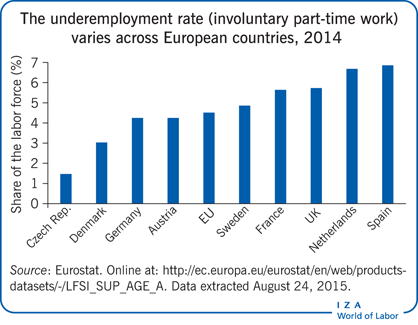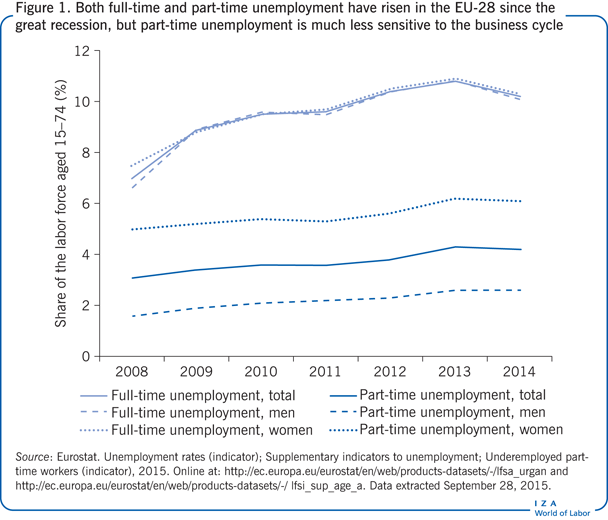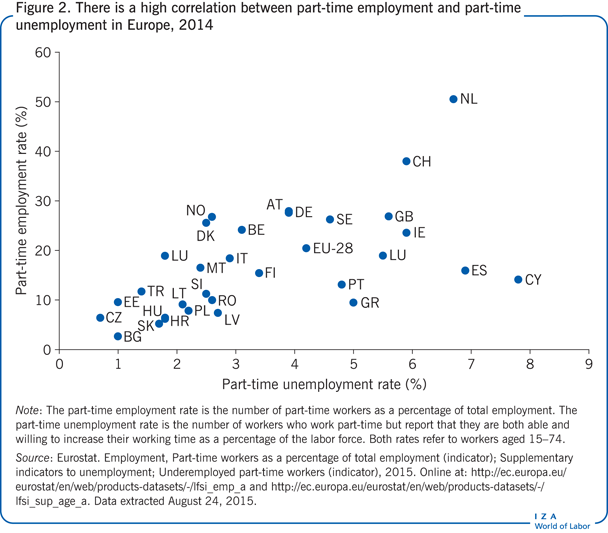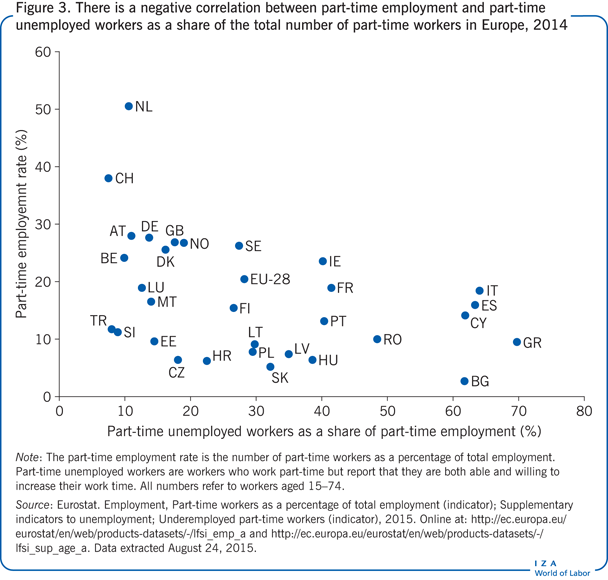Elevator pitch
A considerable share of the labor force consists of underemployed part-time workers: employed workers who, for various reasons, are unable to work as much as they would like to. Offering unemployment benefits to part-time unemployed workers is controversial. On the one hand, such benefits can strengthen incentives to take a part-time job rather than remain fully unemployed, thus raising the probability of obtaining at least some employment. On the other hand, these benefits weaken incentives for part-time workers to look for full-time employment. It is also difficult to distinguish people who work part-time by choice from those who do so involuntarily.

Key findings
Pros
Benefits to part-time unemployed workers strengthen incentives to take on part-time jobs.
Subsidized part-time employment can be a stepping stone toward unsubsidized employment.
Compared with many other systems, unemployment insurance for part-time workers seems to work well as an active labor market policy.
Unemployed workers who move into part-time jobs receive higher earnings, pay higher taxes, take less from the unemployment insurance system, and may receive fewer means-tested benefit transfers.
Cons
If part-time unemployment benefits are too generous, they create a risk for prolonged part-time unemployment spells.
Benefits to part-time unemployed workers weaken incentives to move into full-time employment.
Benefits to part-time unemployed workers could function as an unintended indirect subsidy to sectors with many involuntary part-time workers.
It is difficult for the government to distinguish people who are looking for full-time work from people who work part-time by choice.
Author's main message
For workers who would prefer full-time work, part-time jobs are a stepping stone to regular employment. Thus, partial unemployment benefits for part-time unemployed workers could yield significant welfare gains; they could also lower government spending on unemployment insurance and other transfers to these workers. To counteract the tendency for high benefits to discourage moving from part- to full-time jobs, the benefits should be of short duration and decline over time. Time-limited benefits not only increase incentives for full-time unemployed to move into part-time work, but also to move quickly on to full-time employment.
Motivation
The majority of workers prefer permanent full-time jobs. However, temporary or part-time jobs might be easier for unemployed workers to obtain. Indeed, involuntary part-time workers, who would prefer full-time work, make up a considerable share of the labor force. Still, a part-time job is often regarded as better than no job. Part-time jobs can build the human capital and networks that part-time unemployed workers need in order to succeed in obtaining full-time jobs, and they can lessen the stigma of full-time unemployment. Therefore, many countries allow unemployed workers to accept part-time jobs and still be eligible for partial unemployment insurance. Among the countries with partial unemployment insurance are the US, all Nordic countries, and many other European countries.
Despite discussions of the benefits of partial unemployment insurance to part-time unemployed workers and the common occurrence of part-time unemployment, there is surprisingly little research on unemployment insurance that deals with partial unemployment benefits. One reason might be that part-time unemployment is considered less of a problem than full-time unemployment. Another reason might be the lack of data. In many countries, part-time unemployment is not regularly measured. Furthermore, it is often difficult to obtain data on part-time workers who collect unemployment insurance.
Discussion of pros and cons
What is part-time unemployment?
Part-time unemployment is commonly defined as the underemployment of workers who are willing and able to work additional hours but who work less than full-time in a given week. However, part-time unemployment could be defined over a longer time period. In that case, seasonal unemployment would be included in the definition of part-time unemployment. Indeed, many temporary workers return to their original employers after periods with no work.
Part-time unemployed workers may or may not qualify for unemployment benefits. Most European countries and the US provide partial unemployment benefits to workers if the number of hours worked and their wage income are below certain thresholds. However, partial unemployment insurance could also include individuals who work full-time on short-term contracts and collect benefits in the periods between work contracts. Another related topic is short-term work compensating schemes used during the recent economic crisis, most prominently in Germany. These schemes compensate workers for income loss while on shortened hours. One argument for providing these schemes during a recession is to help maintain employment during harder times. However, they may also impede necessary reallocation and structural change in the labor market.
Part-time unemployment in Europe
This paper is concerned with the primary definition of part-time unemployed workers: workers who are willing and able to work additional hours but who work less than full-time in a given week.
In 2014, more than 20% of employed workers in the EU reported that they worked part-time. Part-time work is most common in the Netherlands, where half of all employees work part-time. Generally, part-time work is unusual in Eastern Europe. Women are far more likely than men to report part-time work. Almost one in three employed women worked part-time in 2014, but only around one in ten men did. On average, part-timers work 20 hours a week.
Many people who work part-time do so by choice. However, a large share of part-time workers want to work more than they do. According to Eurostat (), almost 10 million workers in the EU in 2014 were part-time unemployed, and they accounted for 4.1% of the labor force. Young workers are more likely to be part-time unemployed; their part-time unemployment rate stands at 6.9% of the labor force, compared with 3.2% for the oldest workers.
Part-time unemployment increased in the aftermath of the great recession (Figure 1). However, compared with full-time unemployment, part-time unemployment is much less sensitive to the business cycle. Both part-time and full-time unemployment peaked in 2013. By that time, part-time unemployment had increased 1.2 percentage points since the beginning of the recession, compared with 3.9 percentage points for full-time unemployment. Also, part-time unemployment rates differ between men and women, while unemployment rates are almost identical for men and women.

Generally, countries with a high share of part-time workers also have a high share of part-time unemployed workers (Figure 2). In part, this strong correlation between the share of part-time employment and the share of part-time unemployment might be mechanical. If part-time employment rates are high, naturally more workers could be part-time unemployed.

However, Figure 2 does not necessarily imply that part-time workers are more likely to be part-time unemployed workers in countries where the share of part-time employment is high. Indeed, the correlation is negative between part-time employment and part-time unemployed workers as a share of the total number of part-time workers (Figure 3). Where part-time employment is less common, a larger share of those workers are involuntary part-time workers. One explanation for this result could be that part-time work is associated with a larger stigma in countries where part-time work is uncommon.

Transition to full-time work
There is a large literature on the transition from non-regular employment, mainly temporary contract work, into regular employment. The consensus seems to be that non-regular employment might be a stepping stone to regular employment. A similar argument can be made for part-time jobs.
While the human capital of an unemployed worker declines, the human capital of an unemployed worker who takes on a part-time job increases. A part-time job is also a good opportunity to build networks and perhaps even to gain regular full-time employment at the place of part-time work. Having part-time work lifts some of the stigma associated with unemployment; part-time work may also be easier to obtain than full-time work. The longer a person is unemployed, the lower the probability of getting a call-back on a job application or an interview [1]. In that context, offering part-time benefits can be viewed as an active labor market measure. Part-time unemployment benefits incentivize unemployed workers to remain engaged in the labor market. Compared with the success rates of many other approaches to unemployment, the transition rates from part-time unemployment to regular employment seem fairly high.
However, there is a significant risk of lock-in effects in part-time unemployment. Part-time work may distract workers from more productive job search activities. Working part-time and receiving a top-up on one’s income through partial unemployment benefits might be an attractive option for some workers, thus reducing the incentive to search for full-time employment. When part-time work becomes more attractive, some unemployed workers might also focus their job search activities on part-time jobs, thus short-circuiting or delaying the transition to full-time employment.
Indeed, part-time unemployed workers are less likely to apply for additional work than unemployed workers are to apply for a job. Furthermore, many part-time unemployed workers do not actively engage in job search activities on the labor market but rather seek to increase the number of hours they work at their current job [2]. In addition, some part-time workers adjust their labor supply to gain from combined earnings and benefits, and these effects could be widespread [3], [4]. Therefore, it might be even more important to monitor the job search activities of part-time unemployed workers claiming benefits than it is to monitor those of unemployed workers who are receiving benefits.
In-work benefits and unemployment insurance
Benefits to part-time unemployed workers can also be viewed as an in-work benefit that boosts incentives to move from unemployment to employment. For example, in the US in the late 1980s and early 1990s, raising the earnings ceiling for unemployment benefits eligibility shortened unemployment spells and increased the probability of getting a part-time job [5]. The transition rates from full-time unemployment to part-time unemployment rose for workers early in their unemployment spell, suggesting that part-time benefits could reduce the risk of long-term unemployment. However, although providing unemployment benefits to part-time workers improves incentives for unemployed workers to accept part-time employment, these benefits also reduced incentives to move on to full-time employment.
In a search-and-matching framework, a model that relates workers searching for jobs and firms with vacancies, part-time benefits increase transitions from unemployment to part-time work and decrease transitions from part-time to full-time employment [6]. The result is a rise in part-time employment and part-time unemployment and a decline in full-time employment. One way to counteract the smaller outflow from part-time unemployment to full-time employment as a result of providing unemployment benefits for the part-time unemployed would be to introduce time limits on the benefits. There is a non-negligible welfare gain associated with time-limited part-time benefits, with the size of the welfare gain dependent on how responsive wages are to part-time benefits.
Empirical evidence
Most of the recent empirical evidence is on the Nordic countries. These studies employ a timing-of-events approach to separate the causal effects from the selection effects into part-time unemployment. In general, fully unemployed workers differ from part-time unemployed workers. For example, some studies find evidence of a negative selection effect into part-time unemployment; fully unemployed workers move to full-time employment more quickly than part-time unemployed workers [7], [8]. It seems that unemployed workers with good job prospects are less likely to accept part-time work than workers with worse prospects. In many countries, there is a wage penalty associated with part-time jobs. However, a recent Australian study finds a wage premium associated with part-time work once the study controls for differences among workers [9]. Therefore, it is important to deal with these significant selection effects to be able to determine the causal effects of part-time unemployment insurance.
A Norwegian study concludes that part-time benefits reduce the time until self-supporting employment, and it finds no lock-in effects [7]. This positive effect is driven mainly by higher transition rates into regular employment during the first month of part-time unemployment. During the first month, the study also finds an increase in transitions to high-quality jobs. In many cases, employers appear to use part-time work as a screening device when hiring workers from the unemployment rolls. More than 80% of workers transitioning from part-work to regular work did so at the same employer. In addition, part-time benefits reduce the total amount the government spends on unemployment benefits as the benefits are lower for part-time unemployed workers than for full-time unemployed workers.
Similar results are found for other countries. Subsidized part-time jobs for unemployed workers are a stepping stone toward regular employment for men in Finland and for young women in Belgium [8], [10]. The Finish study concludes that very short-term full-time jobs are used as a screening device by some employers, but they find no such effect for the part-time unemployed workers. Neither study finds evidence of lock-in effects.
In contrast, a Danish study finds significant lock-in effects in part-time unemployment [11]. The Danish system of unemployment benefits is more generous than the other systems studied. In Denmark, the transitions into full-time jobs decrease significantly right after entry into part-time jobs eligible for partial unemployment benefits. However, after the period of part-time unemployment, the transitions to full-time jobs increase, suggesting that part-time work makes unemployed workers more hirable. The results differ between groups. Providing benefits for part-time unemployed workers seems most helpful to young workers and immigrant workers, for whom it serves mainly as a stepping stone to full-time employment. For these workers, it is likely that such subsidized part-time work improves their human capital and strengthens their labor market networks, thus increasing their employment probabilities. Workers who already have strong ties to the labor market gain less and experience the largest lock-in effects.
These empirical studies suggest that providing unemployment benefits for part-time jobs creates a stepping stone to regular employment. Government spending on unemployment insurance may also fall when unemployed workers gain some earnings in the labor market. Unemployed workers who move into subsidized part-time jobs receive higher earnings, make smaller withdrawals from the unemployment insurance system, and may also receive lower means-tested benefit transfers. In addition, they contribute to production and pay higher taxes. However, providing benefits to part-time unemployed workers also seems to produce some negative effects in certain settings. The nature of these effects depends on the context and how the incentives are designed. The exact rules and regulations for unemployment benefits for part-time unemployed workers matter.
Indirect subsidies of businesses with many part-time unemployed workers
Part-time unemployment benefits may work as an indirect subsidy for businesses with high levels of involuntary part-time workers, which can have adverse effects on competition. While the prevalence of this effect has not been studied, a possible way to deal with such indirect subsidies is through an experience rating system. In an experience rating system, employers’ contributions to unemployment insurance vary with the number of their previous employees who are collecting unemployment benefits. Experience rating has been in place in the US for decades [12].
Experience rating is controversial. In countries with strict employment protection legislation, firms already face an implicit tax on layoffs. Also, if the experience rating depends on the length of former employees’ future unemployment spells, firms might discriminate against job applicants who have a high probability of experiencing long-term unemployment. On the other hand, with this kind of system, firms with many part-time unemployed workers claiming benefits would have to contribute to their financing. Therefore, the case for experience rating seems to be stronger for part-time unemployed workers than for full-time unemployed workers. Experience rating for part-time unemployment insurance lowers the risk of indirectly subsidizing sectors with a large share of part-time workers; at the same time, experience rating for employees who are part-time unemployed may have less detrimental effects on selective labor demand.
Limitations and gaps
In addition to the effect of indirect subsidies on businesses with high levels of part-time workers, another issue that has not been closely examined concerns how to distinguish involuntary part-time workers from people who work part-time voluntarily. If part-time unemployed workers have access to unemployment benefits, some voluntary part-time workers might also try to claim these benefits. A simple search-and-matching model suggests that part-time benefits might still be advisable even if it is impossible to distinguish between these two groups [6].
Summary and policy advice
All in all, it appears that making unemployment benefits available to part-time unemployed workers can have beneficial effects on the labor market. Unemployment benefits for part-time unemployed workers increase incentives for unemployed workers to move into part-time jobs, which seem to work as a stepping stone to full-time work. However, the beneficial effects depend on the design of the unemployment insurance scheme. The positive stepping-stone effects are more pronounced in the beginning of the part-time unemployment period. Providing benefits to part-time unemployed workers has also been shown to reduce the risk of long-term unemployment. However, there is a risk that benefits to part-time unemployed workers will reduce their search efforts while they are working part-time, which prolongs their unemployment spells.
Therefore, the optimal system includes time-limited benefits to part-time unemployed workers, in order to encourage them to take up part-time work but also to continue to search for full-time opportunities. To lower the risk of moral hazard, it is also advisable to monitor the search behavior of part-time unemployed workers, to ensure that they are actively looking for full-time work.
Part-time jobs are often viewed as low-quality jobs with lower wages and fewer prospects than full-time jobs. However, part-time workers differ from full-time workers. Part-time jobs are considered better than no job, especially for workers in those jobs, after differences between the two groups are accounted for. Some evidence suggests that part-time jobs are at least as good as full-time jobs for the group of workers who are mainly in part-time jobs, although the research is mixed on this topic.
The optimal design of a part-time unemployment benefit system depends on country-specific factors. However, policymakers should keep in mind that part-time unemployment insurance aims at reducing the risk for long-term unemployment, reducing human capital losses during unemployment, and establishing a stepping stone to self-sufficiency. Therefore, it is important that supplementary benefits are of short duration and that the search efforts of part-time unemployed workers are monitored more closely than the search efforts of unemployed workers.
In many respects, providing partial unemployment benefits for part-time jobs can also be viewed as an active labor market policy. Thus, it might be advisable to direct these benefits to workers with weaker connections to the labor market. The results of the Danish study suggest that youth and immigrant workers reap the largest gains from part-time unemployment insurance [11].
Acknowledgments
The author thanks two anonymous referees and the IZA World of Labor editors for many helpful suggestions on earlier drafts.
Competing interests
The IZA World of Labor project is committed to the IZA Guiding Principles of Research Integrity. The author declares to have observed these principles. The analysis and conclusions expressed in this article are those of the author and not necessarily those of the Confederation of Swedish Enterprise.
© Susanne Ek Spector